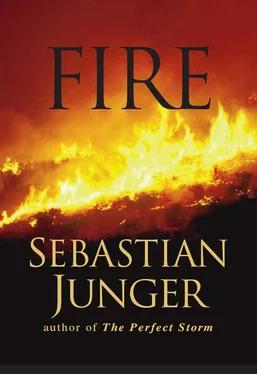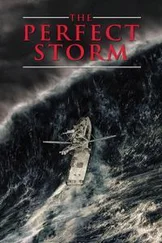One hundred and seventeen miles of fire line had been built, there were only ten more miles to build, and overhead was saying that the fire was nearly contained. Everyone knew that one good spot into some timber could start the fire running again, though. Bird’s briefing was short and to the point, and sunlight was just touching the upper ridges when the three crews shouldered their packs and started off up the hillside. I fell in with the Union Hotshots, followed by Karen Miranda, and we worked our way slowly up a steep drainage that ended at a ridge, heavy timber on the far side. Burned timber. In the absence of wind, the ridge had acted as a fire line, and Union was simply going after the spots that had made it over. Spots were anything from a few square feet of ash to a vigorously flaming snag surrounded by an acre of black, but they all had to be put out. We were in sparse alpine fir now, Kelly Esterbrook said, and fire in alpine fir is very hard to fight. The trees blow sparks as they burn, igniting spot fires everywhere, and they grow in dense groves that provide critically high fuel loads when the fire reaches them. The flames climb up into the trees from the lower branches, which often reach to the ground, and make their way up into the densely packed crowns. A crown fire is particularly hard to stop because the fire moves from tree to tree without ever touching the ground. You can stop a crown fire only by cutting a lot of trees down, and after a certain point it becomes a case of cutting down the forest to save it.
The Union crew spread out in pairs to hit the spot fires and Miranda and I climbed on to the crest of the ridge. Below us, an entire river drainage of charred trees stretched away to the west. Occasionally a solitary tree torched down in the valley and sent up a tremendous plume of smoke. A temperature inversion had trapped the smoke low in the valley, and Miranda said that when it lifted—when the smoke started to rise—that meant that the air was turning over, and convection would invigorate the fire. At that point they would probably call in a substantial air attack in an effort to keep the fire contained on the west side of the ridge.
We followed the ridge, which climbed toward a peak that we had seen above camp. Below us on our right, the forest smoked. Below us on our left, hotshots worked the spot fires in small groups of three or four. An enormous Siller Brothers Skycrane helicopter with a bucket clattered up and down the valley, unleashing two thousand gallons of Smith Creek Lake water at a time. Four sawyers from the Smokey Bear crew dropped a flame-gutted ponderosa and then called in a water drop, and the Skycrane responded in minutes. Two thousand gallons, hitting a hillside from a hundred feet, is practically enough water to body surf downhill through the trees. When the water subsided, the sawyers bent over and began grubbing through the wet soil for embers.
Twenty minutes later, as they were finishing up, a message came over their radio from the fire camp: “Steve Shaeffer, Steve Shaeffer, Smokey Bear, your wife is in the hospital at this moment having a baby.” The sawyers grinned at one another; it was rare that overhead called with personal news that wasn’t bad. Shaeffer was farther up the ridge, hitting spots alongside the Negrito crew. He wasn’t able to go home, but at least he’d gotten the news.
At the top of the ridge we were met by the branch director, a strapping dark-haired man with a white-flecked beard and wind-burned face named Mike Rieser. He had fought fires since 1973 and was now fire control officer for the BLM Craig District in Colorado. We sat down and opened our lunches on a rock outcrop that overlooked the burning valley.
Rieser has personally known eight people who died on fires. “Wildland fire fighting has one of the highest incidences of fatalities and injury in the country,” he said. “In 1990 twenty-three people died, out of ten thousand active fire fighters. Six died on the convict crew at the Dude fire in Arizona, and that same week two were burned over in California. I saw a film of the first walk-through after the Dude fire; the heat varied so much that one shelter would be fine and the next one would have started to disintegrate.”
The Dude fire happened along the Mogollon Rim, on the north side of the Grand Canyon. It was a classic plume-dominated fire, but the topography of the rim served to intensify the downdrafts. Moments before the fire blew up, the Prescott Hotshots noticed a strange calm that often precedes a plume-dominated situation and radioed the overhead team that they were pulling out. The Perryville inmate crew and the Navajo Scouts crew were warned of the danger as well, but they were in exactly the wrong spot. The downdraft hit right in front of them and, funneled by the contours of the canyon rim, drove the fire straight toward them. Half the inmate crew escaped, as did the entire Navajo Scouts crew. The rest of the fire fighters dived into their shelters and waited for the flame front to pass over them.
From laboratory tests, researchers know that the adhesive that holds fire shelters together starts to melt at six hundred degrees Fahrenheit. That causes the fiberglass and aluminum layers to delaminate, in turn leading to rips and holes in the shelter. After the Dude fire, investigators found hard hats that had melted, leather gloves that had shrunk down to a couple of inches, and fire shelters that had begun to delaminate. Six men died, all from breathing superheated air. In all six cases they died because they had not deployed their shelters properly or because they had tried to leave them too quickly. Some of the survivors also suffered terrible burns, which suggest another possibility. The men who left the safety of their shelters may have done so because they thought they were dying inside them.
Mike Rieser and I sat on a rock outcrop eating our lunches and watching the fire. The sun was very hot and trees torched occasionally down in the valley. Every five minutes the Skycrane went by with a tremendous whump of rotors and released another two thousand gallons of Spring Creek Lake. Clouds began to move in above us, and Rieser said that they were called lenticular clouds and that the sculpted tops meant that the upper-level winds were over one hundred miles an hour. If those winds made it down to ground level, they would have a catastrophic effect on the fire. It was his job as branch director to watch out for things like lenticularis formations or castellanus or stage three cumulonimbus or anything else that might make the fire blow up. Two days earlier Rieser had pulled two entire divisions out of a canyon because he hadn’t liked the way the fire was behaving.
“We might not look like we’re doing much, but if you’re down in the valley digging, you don’t see what’s coming at you,” he said. “Air can rise off a fire, cool in the upper atmosphere, and rush back down. It superheats as it comes down and can overpower the wind field. That’s called a plume-dominated fire. It defies prediction. It’s what killed the people at the Dude fire; the ’shot crews recognized plume-dominated conditions, but the convict crew didn’t. No one could get word to them in time.”
Stage three cumulonimbus, thunderclouds, are a particular hazard. Not only do they introduce more lightning into the situation, but the air beneath their thirty-thousand-foot heads is extremely unstable. They can generate downward-moving winds of as much as one hundred miles an hour that hit the ground and spread out in a tremendous circle. The effect is to intensify the interaction among all three components of what is known as the fire triangle: fuel, oxygen, and heat. Ground winds spread dry, hot air through as yet unburned fuels, resulting in more fire and more heat, which in turn circulate more air, spreading the fire even faster. The result is a feedback loop that can be brought under control only if the relationships within the fire triangle break down—either by lowering the temperature of the fire or by depriving it of fuel. Water and retardant drops can bring the temperature of a fire down, and fire lines can deprive it of fuel. Otherwise, the fire spreads until the weather changes or there’s nothing left to burn.
Читать дальше












